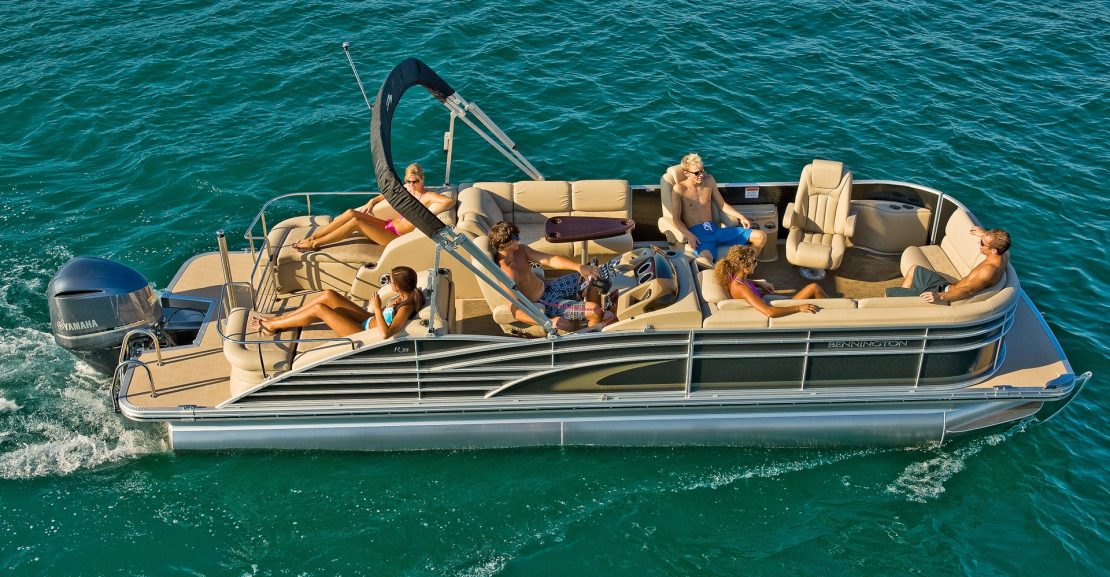For the last several years, a new generation of increasingly versatile and luxurious pontoon boats has been gaining ground in the North American market. Although demand for conventional 18- to 24-foot boats remains stagnant in Canada and the United States, sales of pontoon boats with aluminum tubes have been growing steadily by more than 20% each year since 2009.
Previously thought of as boats for seniors and used on small, calm lakes, pontoon boats are now sought after as an entry-level vessel by an increasingly youthful and diverse clientele who pursue a wide variety of aquatic activities. The growing popularity of pontoons is due to several converging factors, including their ability to accommodate a large number of people at once, their highly affordable pricing compared to other kinds of boats, and the arrival of a “new wave” of versatile, luxurious and reliable pontoon boats.
All aboard!
The most significant feature of a pontoon boat is its ability to carry a large number of people at the same time. Thus, users can invite the whole family, friends and even friends of friends. For example, a 22-foot pontoon boat can safely and comfortably hold 14 passengers without any flotation issues. That’s twice as many people as a 22-foot bowrider (boat with a fibreglass V-shaped monohull). Plus, all passengers can sit comfortably thanks to layouts that almost always include captain’s chairs, leather benches and a table, couches, a dressing room and a sunpad.
Affordable pricing and costs
Pontoon boats also owe their popularity to their relative affordability, especially when compared to fibreglass boats. For example, the average price of a 22-foot pontoon boat with a 90hp engine and a camper enclosure is somewhere between $25,000 and $32,000, while a fibreglass bowrider of the same size equipped with an equivalent inboard/outboard motor normally sells for anywhere from $40,000 to $55,000. The 40% difference in price can tip the balance in favour of a pontoon boat as a first purchase.
Furthermore, pontoon boats are generally powered by a new generation of outboard motors (electronic four-stroke engine). These new engines are both powerful and fuel-efficient. Fuel consumption for such outboard motors are two times lower than that of an inboard/outboard motor with equivalent power.
Finally, annual maintenance costs for pontoons with an outboard motor are low compared to fibreglass boats with an inboard motor.
New-wave pontoon boats
The enthusiasm for pontoon boats that has taken hold in the last five years also coincides with an increasingly large selection of models over multiple product lines. Most pontoon boat manufacturers now offer a range of 15 to 20 different models measuring anywhere from 18 to 30 feet. This is great news for consumers. With a wider array of choices, new buyers have a much easier time entering the pleasure-boating world in a way that fits their needs, budgets and preferences.
“New-wave” pontoon boats are also versatile, practical and can be extremely luxurious. Although some models are intended for specific activities such as fishing, diving, weekend trips, towed tubing or waterskiing, you can always use these boats for trips, picnics, sunbathing and relaxing with friends. Luxury now comes in a variety of forms: depending on the model they want, buyers can choose from a selection of consoles, quality of finished leather for couches and benches, flooring or optional built-in features such as a stainless-steel barbecue, full-size bed, refreshment centre, bar, refrigerator, flush toilet, sound system with retractable speakers and other innovative additions to the ever-expanding list of options.
Three tubes for better performance
Adding a third pontoon (sometimes called the “performance package”) ensures better buoyancy and greater stability. Furthermore, three-tube pontoon boats can handle more powerful engines. While a 22-foot two-tube pontoon boat is limited to a maximum of 115hp, a three-tube boat in the same size can take a 200hp engine. Some three-tube pontoon boats with a reinforced structure can even handle a 300hp engine.
Most of all, the three-tube package offers quicker planing, higher speeds at all rpms and much better manoeuvrability. As a result, three-tube pontoon boats can compete with fibreglass monohull boats and are worth considering for trips over large bodies of water or simply as a high-performance option for water sport lovers.
“If this trend holds”
Pontoon boats are more than just a passing fad; they have a promising future. Thanks to their versatility, value for money and an increasingly luxurious selection of models, this type of boat has become and will remain a long-lasting, sound investment. We can therefore expect manufacturers to continue improving these products. There are already pontoon boats with more stylized shapes, modern interior design and technical innovations—and the result is higher-performance boats that are better adapted to the many pleasures of boating.

